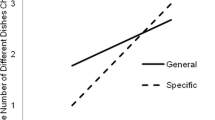Abstract
Existing models view variety seeking as the result of differences in the level of attribute satiation across attributes. An alternative within-attribute variety-seeking (WAVS) model is proposed. The model posits that variety seeking occurs among the nested features, or meaningful value ranges, of an underlying dimension. The resulting pattern of consumption is represented as an oscillation about a consumer's ideal point on the dimension. An empirical study that illustrates different oscillation patterns is reported.
Similar content being viewed by others
References
Bawa, Kapil. (1990). “Modeling Inertia and Variety Seeking Tendencies in Brand Choice Behavior,”Marketing Science 3 (Summer), 263–278.
Best, Roger. (1976). “Predictive Aspects of a Joint-Space Theory of Stochastic Choice,”Journal of Marketing Research 13 (May), 198–204.
Farquhar, Peter H., and Vithala R. Rao. (1976). “A Balance Model for Evaluating Subsets of Multiattributed Items,”Management Science 5 (January), 528–539.
Gati, Itamar, and Amos Tversky. (1982). “Representations on Qualitative and Quantitative Dimensions,”Journal of Experimental Psychology: Human Perception and Performance 8(2), 325–340.
Givon, Moshe. (1984). “Variety Seeking through Brand Switching,”Marketing Science 3(1), 1–22.
Jeuland, Abel P. (1978). “Brand Preference Over Time: A Partially Deterministic Operationalization of the Notion of Variety Seeking.” In Subashi Jain (Ed.),Research Frontiers in Marketing: Dialogues and Directions (Vol. 43), (pp. 33–37). AMA 1978 Educators' Proceedings. Chicago: American Marketing Association.
Johnson, Michael D., and Claes Fornell. (1987). “The Nature and Methodological Implications of the Cognitive Representation of Products,”Journal of Consumer Research 14 (September), 214–228.
Johnson, Michael D., Donald R. Lehmann, Claes Fornell, and Daniel R. Horne. (1992). “Attribute Abstraction, Feature-Dimensionality, and the Scaling of Product Similarities,”International Journal of Research in Marketing 9(1), 131–147.
Lattin, James M. (1987). “A Model of Balanced Choice Behavior,”Marketing Science 6 (Winter), 48–65.
Lattin, James M., and Leigh McAlister. (1985). “Using a Variety-Seeking Model to Identify Substitute and Complementary Relationships Among Competing Products,”Journal of Marketing Research 22 (August), 330–339.
Lehmann, Donald R. (1972). “Judged Similarity and Brand-Switching Data as Similarity Measures,”Journal of Marketing Research 9 (August), 331–334.
McAlister, Leigh. (1982). “A Dynamic Attribute Satiation Model of Variety Seeking Behavior,”Journal of Consumer Research 9 (September), 141–150.
Myers, James H., and Allan D. Shocker. (1981). “The Nature of Product Related Attributes,”Research in Marketing 5, 211–236.
Park, C. Whan. (1976). “The Effect of Individual and Situation-Related Factors on Consumer Selection of Judgmental Models,”Journal of Marketing Research 13 (May), 144–151.
Park, C. Whan. (1978). “A Conflict Resolution Choice Model,”Journal of Consumer Research 5 (September), 124–137.
Prinz, W., and G. Scheerer-Neuman. (1974). “Component Processes in Multiattribute Stimulus Classification,”Psychological Research 37(11), 25–50.
Quandt, Richard E. (1983). “Computational Problems and Methods.” In Z. Griliches and M. Intriligator (Eds.),Handbook of Econometrics (Vol. 1). Amsterdam: North Holland.
Author information
Authors and Affiliations
Rights and permissions
About this article
Cite this article
Johnson, M.D., Herrmann, A. & Gutsche, J. A within-attribute model of variety-seeking behavior. Marketing Letters 6, 235–243 (1995). https://doi.org/10.1007/BF00995114
Issue Date:
DOI: https://doi.org/10.1007/BF00995114




